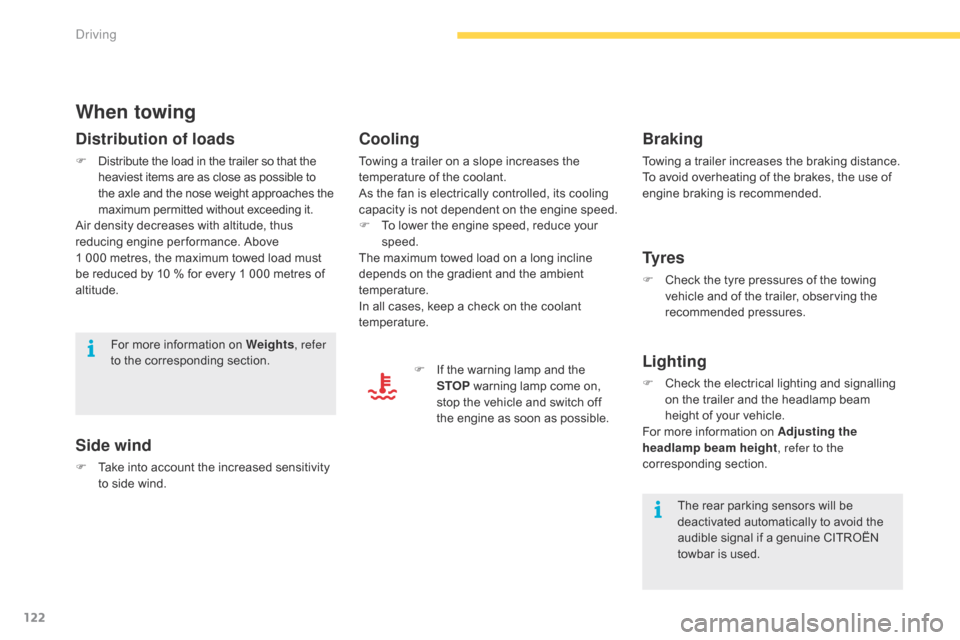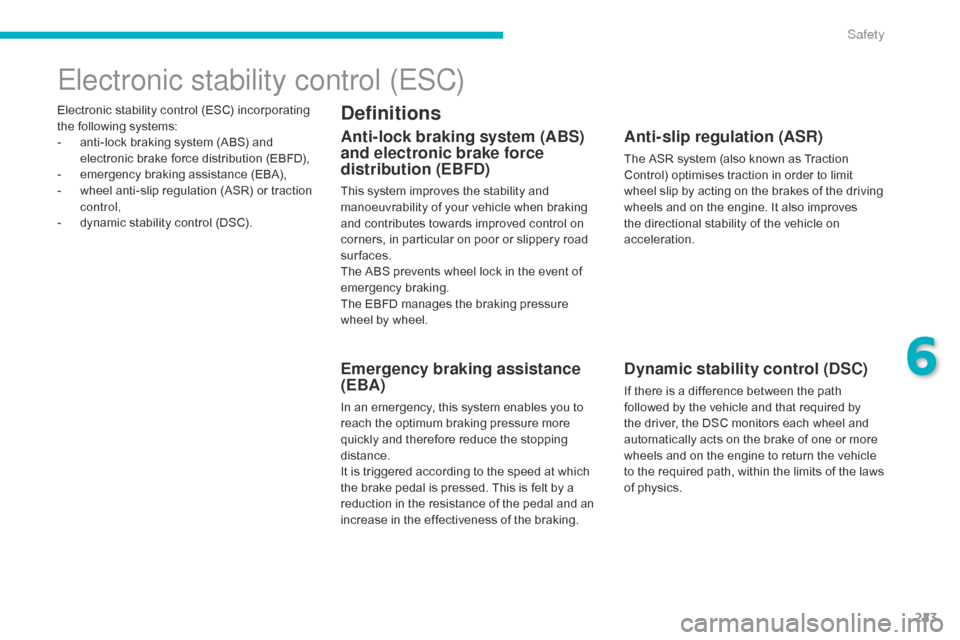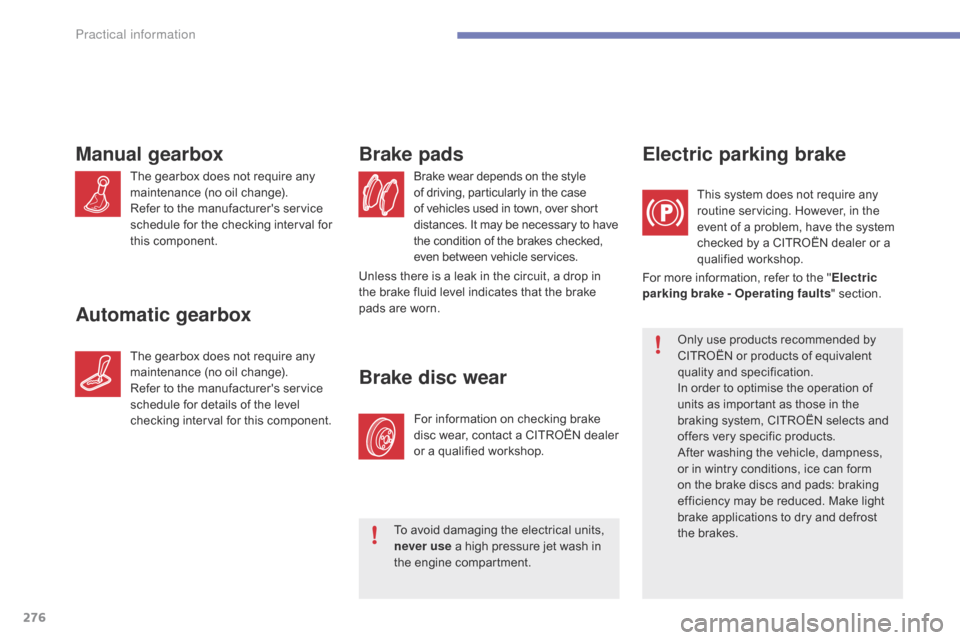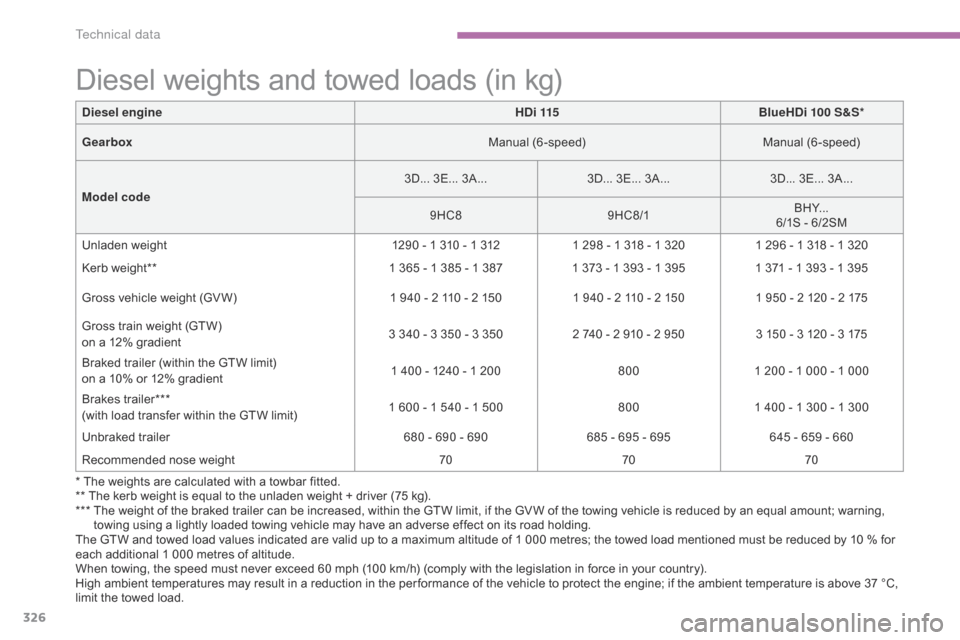brakes Citroen GRAND C4 PICASSO RHD 2016 2.G Owner's Manual
[x] Cancel search | Manufacturer: CITROEN, Model Year: 2016, Model line: GRAND C4 PICASSO RHD, Model: Citroen GRAND C4 PICASSO RHD 2016 2.GPages: 523, PDF Size: 13.63 MB
Page 124 of 523

122
When towing
Distribution of loads
F Distribute the  load  in  the  trailer  so  that  the h
eaviest  items  are  as  close  as  possible  to t
he  axle  and  the  nose  weight  approaches  the
 m
aximum  permitted  without  exceeding  it.
Air
 density  decreases  with  altitude,  thus Â
r
educing  engine  per formance.  Above Â
1Â 0
00 metres,  the  maximum  towed  load  must Â
b
e  reduced  by  10 %  for  every  1 000  metres  of Â
al
titude.
Side wind
F Take  into  account  the  increased  sensitivity  t
o  side  wind.
For
 more  information  on  Weights
, refer
to  the  corresponding  section.
The  rear  parking  sensors  will  be Â
d
eactivated  automatically  to  avoid  the Â
a
udible  signal  if  a  genuine  CITROĂ‹N Â
t
owbar  is  used.
Cooling
Towing a trailer on a slope increases the temperature  of  the  coolant.
As
 the  fan  is  electrically  controlled,  its  cooling Â
c
apacity  is  not  dependent  on  the  engine  speed.
F
Â
T
o  lower  the  engine  speed,  reduce  your Â
s
peed.
The
 maximum  towed  load  on  a  long  incline Â
d
epends  on  the  gradient  and  the  ambient Â
t
emperature.
In
 all  cases,  keep  a  check  on  the  coolant Â
t
emperature. F
Â
I
f  the  warning  lamp  and  the Â
S
TOP
Â
warning  lamp  come  on, Â
s
top  the  vehicle  and  switch  off Â
t
he  engine  as  soon  as  possible.
Braking
Towing a trailer increases the braking distance.
T o  avoid  overheating  of  the  brakes,  the  use  of Â
e
ngine  braking  is  recommended.
Ty r e s
F Check the  tyre  pressures  of  the  towing  v
ehicle  and  of  the  trailer,  observing  the Â
re
commended
 p
ressures.
Lighting
F Check the  electrical  lighting  and  signalling  o
n  the  trailer  and  the  headlamp  beam Â
h
eight  of  your  vehicle.
For
 more  information  on  Adjusting the
headlamp beam height , refer to the
corresponding
 s
ection.
Driving
Page 192 of 523

190
Park Assist
This system provides active assistance with parking.  It  detects  a  parking  space  then Â
o
perates  the  steering  to  park  in  the  space.
It
 operates  the  steering  while  the  driver Â
m
anages  the  accelerator,  brakes,  gears  and Â
c
lutch  (manual  gearbox).  During  phases  of Â
e
ntry  into  and  exit  from  a  parking  space,  the Â
s
ystem  provides  visual  and  audible  information Â
t
o  the  driver  in  order  to  make  the  manoeuvres Â
s
afe.  It  may  be  necessary  to  move  for wards Â
a
nd  backwards  more  than  once. During
 a  manoeuvre  the  steering Â
w
heel  turns  quickly:  do  not  hold  the Â
s
teering  wheel,  do  not  place  your  hands Â
b
etween  the  spokes  of  the  steering Â
w
heel  and  take  care  with  loose  and Â
b
ulky  clothing,  scarves,  handbags... Â
T
here  is  a  risk  of  injury.
When
 Park  Assist  is  activated,  it Â
p
revents  a  change  to  STOP  mode  of Â
S
top  &  Start.  In  STOP  mode,  activation Â
o
f  Park  Assist  restarts  the  engine.
The
 Park  Assist  system  cannot  in  any Â
c
ircumstances  replace  the  need  for Â
v
igilance  on  the  part  of  the  driver.
The
 driver  must  remain  in  control Â
o
f  their  vehicle  ensuring  that  the Â
s
pace  remains  clear  throughout  the Â
m
anoeuvre.
In
 some  circumstances,  the  sensors Â
m
ay  not  detect  small  obstacles  located Â
i
n  their  blind  spots.
The
 driver  can  take  control  at  any  time  by Â
g
ripping  the  steering  wheel. The
 Park  Assist  system  provides  assistance  for  t
he  following  manoeuvres:
A.
 E
ntry  into  a  parallel  parking  space
B.
 E
xit  from  a  parallel  parking  space
C.
 B
ay
 par
kingThe
 Park  Assist  system  takes  control Â
o
f  the  power  steering  for  a  maximum Â
o
f  4  manoeuvre  cycles.  The  function Â
i
s  deactivated  after  these  4  cycles. Â
I
f  you  think  that  your  vehicle  is  not Â
p
ositioned  correctly,  you  should  then Â
t
ake  control  of  the  steering  to  carry  out Â
t
he  manoeuvre.
The
 Park  Assist  system  cannot  work Â
w
ith  the  engine  off.
Driving
Page 225 of 523

223
Electronic stability control (ESC) incorporating the  following  systems:
-
Â
a
nti-lock  braking  system  (ABS)  and Â
e
lectronic  brake  force  distribution  (EBFD),
-
Â
e
mergency  braking  assistance  (EBA),
-
Â
w
heel  anti-slip  regulation  (ASR)  or  traction Â
c
ontrol,
-
Â
d
ynamic  stability  control  (DSC).
Electronic stability control (ESC)
Definitions
Anti-lock braking system (ABS)
and electronic brake force
distribution (EBFD)
This system improves the stability and manoeuvrability  of  your  vehicle  when  braking Â
a
nd  contributes  towards  improved  control  on Â
c
orners,  in  particular  on  poor  or  slippery  road Â
su
rfaces.
The
 ABS  prevents  wheel  lock  in  the  event  of Â
em
ergency
 b
raking.
The
 EBFD  manages  the  braking  pressure Â
w
heel  by  wheel.
Emergency braking assistance
(EBA)
In an emergency, this system enables you to reach  the  optimum  braking  pressure  more Â
q
uickly  and  therefore  reduce  the  stopping Â
di
stance.
It
 is  triggered  according  to  the  speed  at  which Â
t
he  brake  pedal  is  pressed.  This  is  felt  by  a Â
r
eduction  in  the  resistance  of  the  pedal  and  an Â
i
ncrease  in  the  effectiveness  of  the  braking.
Anti-slip regulation (ASR)
The ASR system (also known as Traction Control)  optimises  traction  in  order  to  limit Â
w
heel  slip  by  acting  on  the  brakes  of  the  driving Â
w
heels  and  on  the  engine.  It  also  improves Â
t
he  directional  stability  of  the  vehicle  on Â
a
cceleration.
Dynamic stability control (DSC)
If there is a difference between the path followed  by  the  vehicle  and  that  required  by Â
t
he  driver,  the  DSC  monitors  each  wheel  and Â
a
utomatically  acts  on  the  brake  of  one  or  more Â
w
heels  and  on  the  engine  to  return  the  vehicle Â
t
o  the  required  path,  within  the  limits  of  the  laws Â
o
f  physics.
6
Safety
Page 227 of 523

225
Anti-slip regulation (ASR)
Activation
This system is activated automatically each time  the  vehicle  is  started.
It
 comes  into  operation  in  the  event  of  a Â
p
roblem  of  grip.
Deactivation
In exceptional conditions (starting a vehicle which  is  bogged  down,  stuck  in  snow,  on  soft Â
g
round...),  it  may  be  advisable  to  deactivate Â
t
he  DSC  and  ASR,  so  that  the  wheels  can  turn Â
f
reely  and  regain  grip.
This
Â
is
Â
indicated
Â
by
Â
the
Â
flashing
Â
of
Â
t
his
Â
warning
Â
lamp
Â
in
Â
the
Â
instrument
Â
pan
el. Reactivate
 the  systems  as  soon  as  the  level  of Â
g
rip  permits.
F
I
n the Driving
Â
menu,  select  the  "Driving
assistance " tab, then "Anti-slip
regulation ".
This
 indicator  lamp  comes  on  in  the Â
in
strument
 pan
el.
The
 ASR  system  will  no  longer  act Â
o
n  the  operation  of  the  engine  and Â
o
n  the  brakes  in  the  event  of  an Â
i
nvoluntary  change  of  trajectory.
After
Â
an
Â
impact,
Â
have
Â
the
Â
system
Â
checked
Â
by
Â
a
 C
ITROĂ‹N
Â
dealer
Â
or
Â
a
Â
qualified
Â
workshop.
Operating fault
Reactivation
The system is reactivated automatically every t
ime  the  ignition  is  switched  back  on  or  from  30 Â
m
ph  (50  km/h).
Below
 30  mph  (50  km/h),  you  can  reactivate  it Â
m
anually:
F
I
n the Driving
Â
menu,  select  the  "Driving
assistance " tab, then "Anti-slip
regulation ".
Illumination
 of  this  warning  lamp, Â
a
ccompanied  by  an  audible  signal Â
a
nd  a  message,  indicate  a  fault  with Â
t
he  system.
Contact
 a  CITROĂ‹N  dealer  or  a  qualified Â
w
orkshop  to  have  the  system  checked.
6
Safety
Page 278 of 523

276
Brake wear depends on the style of  driving,  particularly  in  the  case o
f  vehicles  used  in  town,  over  short
 d
istances.  It  may  be  necessary  to  have
 t
he  condition  of  the  brakes  checked,
 e
ven  between  vehicle  services.
Brake pads
For information on checking brake disc  wear,  contact  a  CITROĂ‹N  dealer Â
o
r  a  qualified  workshop.
Brake disc wear
Only use products recommended by CITROĂ‹N  or  products  of  equivalent Â
q
uality
 an
d
 sp
ecification.
In
 order  to  optimise  the  operation  of Â
u
nits  as  important  as  those  in  the Â
b
raking  system,  CITROĂ‹N  selects  and Â
o
ffers  very  specific  products.
After
 washing  the  vehicle,  dampness, Â
o
r  in  wintry  conditions,  ice  can  form Â
o
n  the  brake  discs  and  pads:  braking Â
e
fficiency  may  be  reduced.  Make  light Â
b
rake  applications  to  dry  and  defrost Â
t
he  brakes.
Electric parking brake
For more information, refer to the "E lectric
parking brake - Operating faults "
 section.
This
 system  does  not  require  any Â
r
outine  servicing.  However,  in  the Â
e
vent  of  a  problem,  have  the  system Â
c
hecked  by  a  CITROĂ‹N  dealer  or  a Â
q
ualified
 w
orkshop.
Manual gearbox
The gearbox does not require any m
aintenance  (no  oil  change).
Refer
 to  the  manufacturer's  service Â
s
chedule  for  the  checking  interval  for Â
t
his
 c
omponent.
Automatic gearbox
The gearbox does not require any maintenance  (no  oil  change).
Refer
 to  the  manufacturer's  service Â
s
chedule  for  details  of  the  level Â
c
hecking  interval  for  this  component.
To
 avoid  damaging  the  electrical  units, Â
n
ever use  a  high  pressure  jet  wash  in Â
t
he  engine  compartment.
Unless
 there  is  a  leak  in  the  circuit,  a  drop  in Â
t
he  brake  fluid  level  indicates  that  the  brake Â
p
ads  are  worn.
Practical information
Page 328 of 523

326
Diesel weights and towed loads (in kg)
The GTW and towed load values indicated are valid up to a maximum altitude of 1 000 metres; the towed load mentioned must be reduced by 10 % for each  additional  1  000  metres  of  altitude.
When
 towing,  the  speed  must  never  exceed  60  mph  (100  km/h)  (comply  with  the  legislation  in  force  in  your  country).
High
 ambient  temperatures  may  result  in  a  reduction  in  the  per formance  of  the  vehicle  to  protect  the  engine;  if  the  ambient  temperature  is  above  37  °C, Â
l
imit  the  towed  load.
Diesel engine
HDi 115BlueHDi 100 S&S*
Gearbox Manual
 (
6-speed)
Manual
 (
6-speed)
Model code 3D...
 3
E...
 3
A...
3D...
 3
E...
 3
A...
3D...
 3
E...
 3
A...
9HC8 9HC8/1 BHY...
6/1S Â - Â 6/2SM
Unladen  weight
1290 Â - Â 1 Â 310 Â - Â 1 Â 312
1 Â 298 Â - Â 1 Â 318 Â - Â 1 Â 320
1 Â 296 Â - Â 1 Â 318 Â - Â 1 Â 320
Kerb  weight**
1 Â 365 Â - Â 1 Â 385 Â - Â 1 Â 387
1 Â 373 Â - Â 1 Â 393 Â - Â 1 Â 395
1 Â 371 Â - Â 1 Â 393 Â - Â 1 Â 395
Gross  vehicle  weight  (GV W)
1 Â 940 Â - Â 2 Â 110 Â - Â 2 Â 150
1 Â 940 Â - Â 2 Â 110 Â - Â 2 Â 150
1 Â 950 Â - Â 2 Â 120 Â - Â 2 Â 175
Gross  train  weight  (GTW)
on  a  12%  gradient
3 Â 340 Â - Â 3 Â 350 Â - Â 3 Â 350
2 Â 740 Â - Â 2 Â 910 Â - Â 2 Â 950
3 Â 150 Â - Â 3 Â 120 Â - Â 3 Â 175
Braked  trailer  (within  the  GTW  limit)
on  a  10%  or  12%  gradient
1 Â 400 Â - Â 1240 Â - Â 1 Â 200
8001 Â 200 Â - Â 1 Â 000 Â - Â 1 Â 000
Brakes  trailer*** Â
(with  load  transfer  within  the  GTW  limit)
1 Â 600 Â - Â 1 Â 540 Â - Â 1 Â 500
800 1 Â 400 Â - Â 1 Â 300 Â - Â 1 Â 300
Unbraked
 t
railer
680 Â - Â 690 Â - Â 690
685 Â - Â 695 Â - Â 695
645 Â - Â 659 Â - Â 660
Recommended  nose  weight
707070
* The  weights  are  calculated  with  a  towbar  fitted.
** The  kerb  weight  is  equal  to  the  unladen  weight  +  driver  (75  kg).
***Â Â
T
he  weight  of  the  braked  trailer  can  be  increased,  within  the  GTW  limit,  if  the  GV W  of  the  towing  vehicle  is  reduced  by  an  equal  amount;  warning,  t
owing  using  a  lightly  loaded  towing  vehicle  may  have  an  adverse  effect  on  its  road  holding.
Technical data